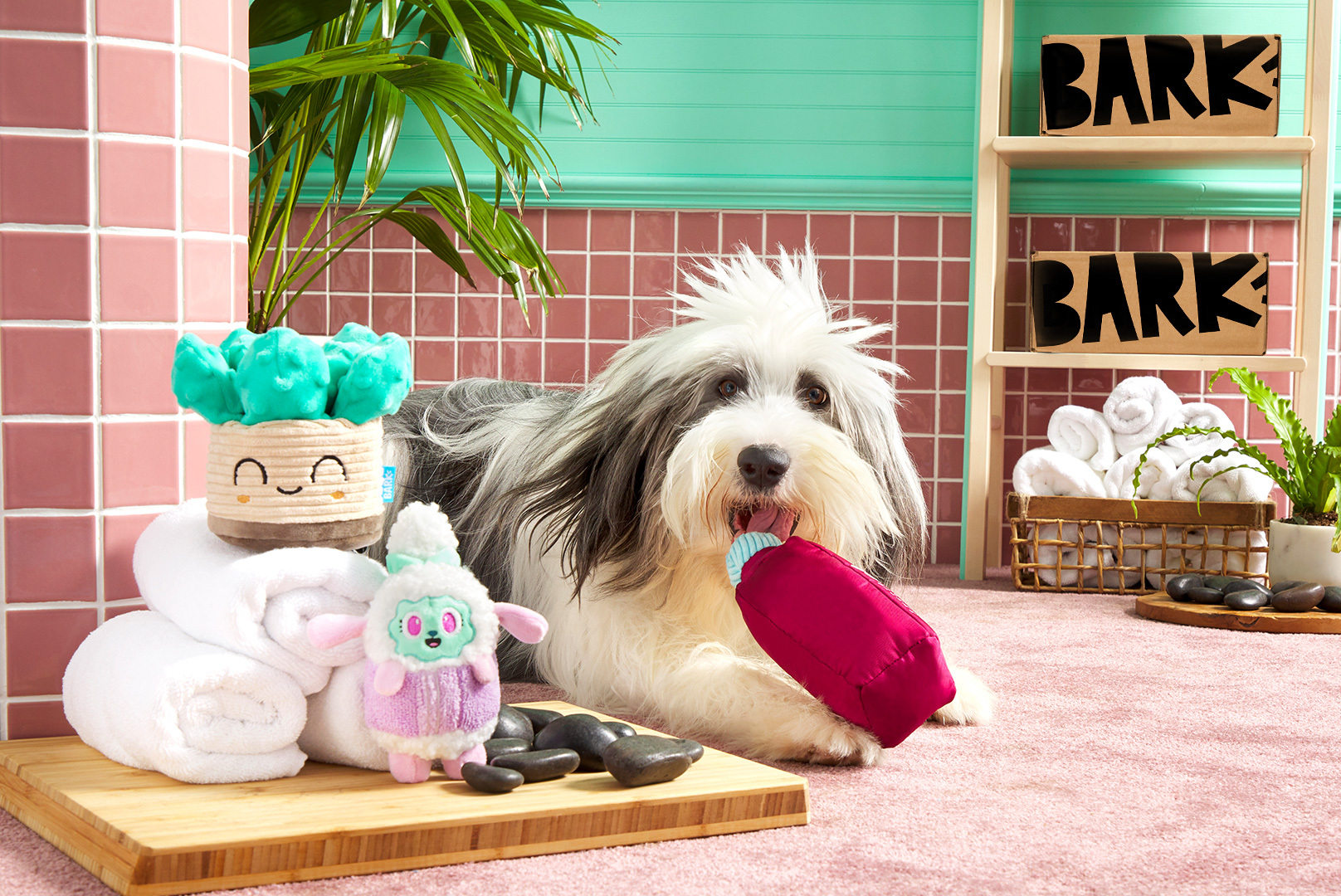The boxer dog is an enigma of a canine. Like the sport-fighters of the same name, boxers are tough cookies with a history of even tougher work. Underneath that rugged exterior, though, lies a sweet and goofy center.
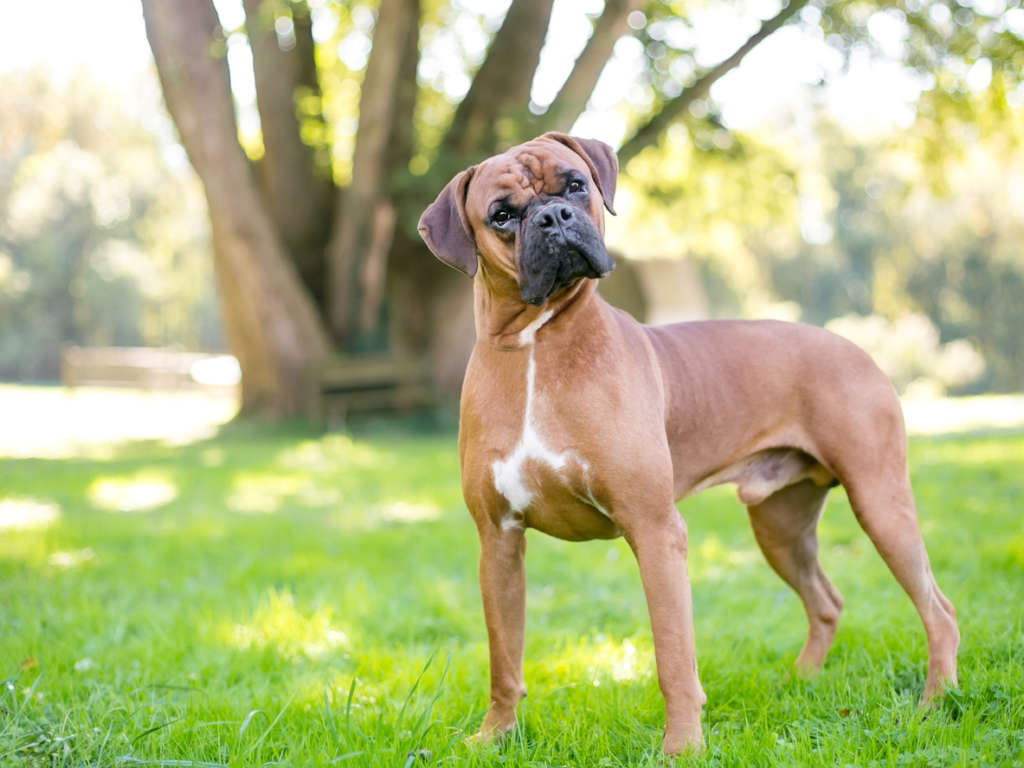

If you’ve ever had the pleasure of romping around with boxer dogs, you know that they can be equal parts silly and stalwart. Ever alert, eternally affectionate, and effortlessly handsome, boxers have claimed their well-deserved spot as one of America’s most beloved dog breeds.
Breed Overview
Boxers Are Also Known As…
German boxer, Deutscher boxer, Rocky, Tyson, Mr. Lean Mean Frowning Machine, “The Muhammad Ali” of dogs.
Boxer Dog Breed Types
Boxers have a distinct face that is lovable and squishable! It’s common across the 5 types of boxer dog breeds.
- American Boxer
- English Boxer (a.k.a. UK Boxer)
- Brindle Boxer
- German Boxer
- White Boxer
What Is The History Of The Boxer?
Trace the boxer’s history way, way back in time—like 4,000 years ago—and it seems likely they evolved from ancient Assyrian fighting dogs. One look at their muscular bodies tells you everything you need to know about that.
However, most hound historians believe the boxer’s most recent ancestor is a large German working dog known as the Bullenbeisser (which means “bull biter”). True to their name, these mighty mutts were raised to hunt big game. Eventually, they were selectively bred to be smaller and more docile. Now, they’re built less for galavanting in Germany’s forests and are better used as a guard dog. The result? The modern boxer.
Toward the beginning of the 1900s, boxers made their way to the United States, remaining relatively unknown for a few decades. But with scores of soldiers bringing boxer pups home after World War II and a young boxer named Bang Away winning the Westminster dog show in 1951, that all changed. To this day, boxers still tend to top the list of America’s most popular pooches.
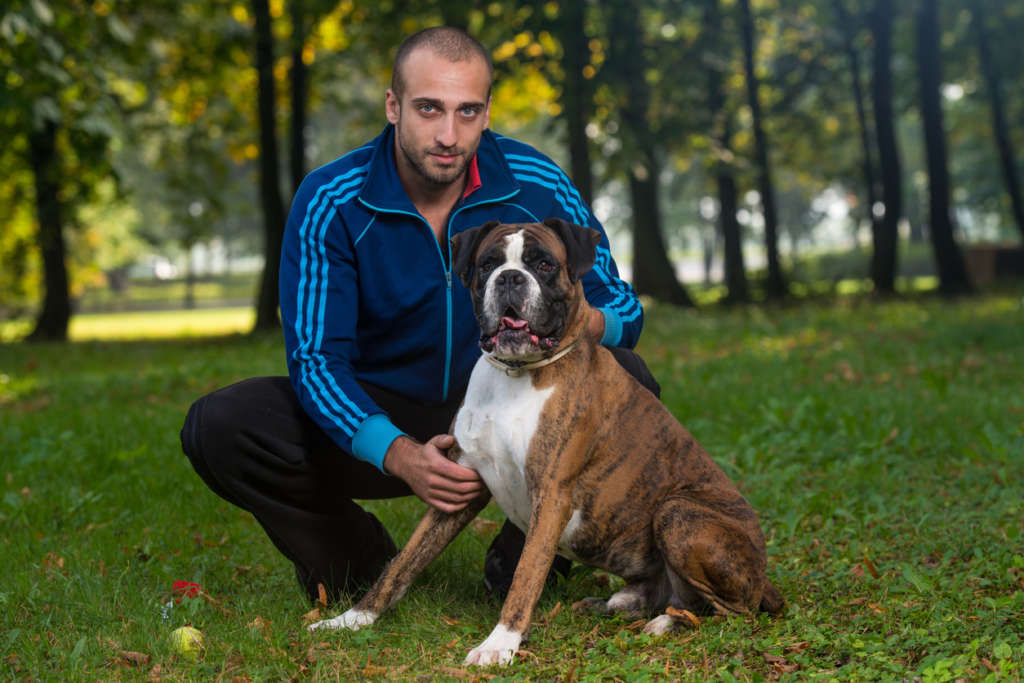

How Big Do Boxers Get?
Regardless if they’re a male or female boxer, this dog breed maintains a consistent size in adulthood. On average, boxer dogs are usually:
Height: 21.5–25 inches
Weight: 50–80 pounds
How Long Do Boxers (Generally) Live?
As a bigger breed, boxers have a shorter lifespan than some of their pint-sized counterparts. Still, you’ll have plenty of time to spend with your beloved boxer—their average life expectancy is 9–12 years.
What Is A Boxer’s Temperament & Personality Like?
Despite their rugged exterior, the boxer makes a delightfully charming companion. Affable and affectionate, these proud pups will lick just about any face they can reach. Boxers want—nay, crave—human affection, and they’ll do whatever it takes to secure it, even if it’s from a stranger.
While boxers are lovingly lovable dogs by default, the breed’s history as a working dog bestowed it with the characteristics of a hunter or guard dog. Whether you’re out for a walk or lounging in the yard, you’ll notice that your boxer is always alert. As such, these pooches are the perfect household guardians: vigilant, loyal, and ready for anything.
Good With Kids? Cats? Dogs?
If boxers weren’t bred for hunting, you might assume they were brought up to be babysitters. Like goldendoodles, this is a breed that lives to play with kids. Even when they’re not in the fray, they’ll gladly watch over your little angels as they play. (Speaking of keeping watch, be sure to supervise your young ones around all dogs.)
As for spending time with other pups, a boxer puppy may not be the first one off the bench, but they get along well enough with other members of their species. Felines are a bit of a different story. Due to their natural prey drive, boxers may look at cats more as a meal than a mate. However, you shouldn’t have any issues if you introduce them to kitties early and often.
In general, the more people and animals your puppy can meet as a young’un, the better. Boxers can become standoffish or scared of others if they don’t socialize enough, leading to fear-based barking and brooding.


Do Boxers Need A Lot Of Exercise?
Those rippling muscles aren’t just for show—boxers are high-energy puppers. The average boxer needs around two hours of exercise every day. In other words, owning a boxer isn’t for the faint of heart—if you’re not in shape now, you certainly will be once your furry personal trainer gets his paws on you.
Boxers also need mental exercise. Behind that strong, square jaw and broad skull lies a capable brain. Consider giving your pup a mentally stimulating task—a job or a puzzle toy, for instance.
If they don’t have enough physical or mental stimulation in their lives, boxers may seek out non-traditional outlets for their energy (read: pull apart a throw pillow or two). Do yourself a favor and bring Bruno along on your morning jog.
Are Boxers Hard To Train?
Remember what we said about boxers doing whatever it takes to earn a healthy dose of human affection? Well, that includes being a good boy or girl!
Boxers love a congratulatory belly rub. As such, they’ve earned a reputation for being easily trainable dogs. All it takes is an early start and a little perseverance, and your boxer will be dancing the tango for treats in no time. This propensity for training also makes the boxer an ideal service dog.
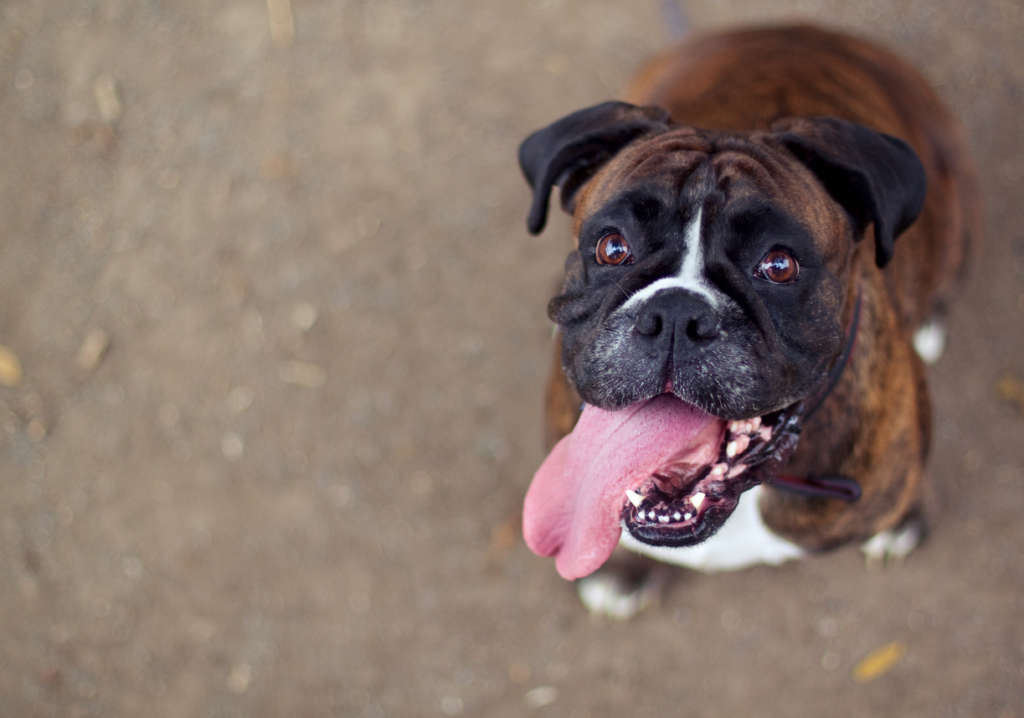

Do Boxers Have Health Issues?
As a larger breed, boxers are more susceptible to certain issues and illnesses than other canines. Some of the more severe health problems to look out for include:
- Hip dysplasia—Taller purebred dogs are prone to hip dysplasia. Aside from Boxers, a few other dog breeds include Rottweilers and Bernese mountain dogs. Eventually, this misalignment of the hip joint can give way to arthritis.
- BOAS—Like pugs and other pups, boxers have short, “squished-in” faces. This face structure can lead to brachycephalic obstructive airway syndrome (BOAS), a condition that makes breathing challenging.
- Epilepsy—While fairly rare, seizures can affect some boxers.
- Cancer—Certain forms of cancer are also more prevalent in this breed.
Additionally, boxers can suffer from eye, heart, and skin problems—especially around the skin folds on their faces. However, don’t stress too much about your furry friend’s health. Responsible pet owners screen for severe issues ahead of time, and with frequent vet visits and routine care, you can give your boxer a long, healthy life. However, any health concern you have, consult with a vet.
Do Boxers Need To Be Groomed?
Because boxers shed their short, smooth coat, they don’t need to visit the groomer for a haircut. With that said, they still require a spa day from time to time—aim for every two months or so. Boxers aren’t particularly messy mutts, but a quick brush every few weeks will keep them looking fresh. You shouldn’t need to bathe your boxer too often (unless they find a mud pit on your daily walk).
As with all dogs, boxers have other grooming needs. Don’t forget to pencil in a periodical tooth scrub, ear cleaning, and semi-regular pedicures.
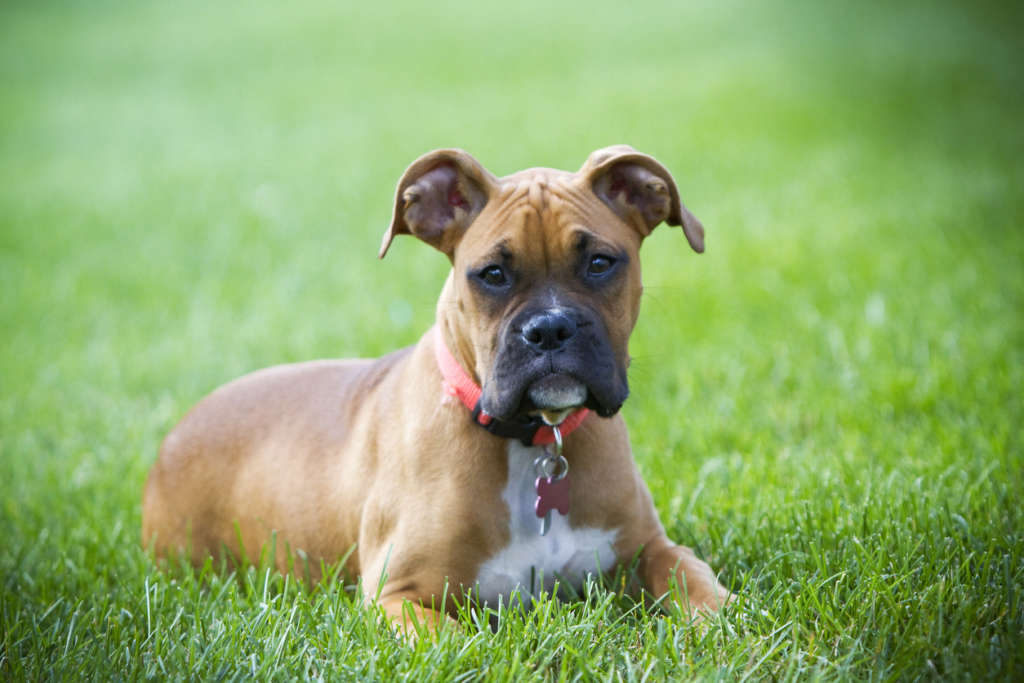

How Much Does It Cost To Care For A Boxer?
The boxer is an ideal companion for any dog lover, but there’s a financial responsibility that comes with canine ownership. Not including the cost of adopting, you should budget $1300+ per year to care for a boxer. (Keep in mind that your expenses will depend on your lifestyle and cost of living.)
How Much Dog Food Does A Boxer Need?
Boxers have an appetite that matches their stature, so dog food will likely take up a sizable chunk of your budget. Adult pups can chow down on close to three cups of kibble each day, bringing your average cost to $35–80 per month.
BARK makes food specifically for boxers and boxer mixes! Get 25% off with code 25FOOD and free shipping!


Routine Vet Care (Healthy Dog)
Regular vet visits are essential to keeping your boxer feeling their best. Expect to spend ~$200 per year on routine checkups. Costs include:
- Vet fees (~$50 per visit)
- Vaccines ($20–$30 per dose)
- Heart disease tests (~$45)
As your boxer grows older, you can expect to pay a little more in vet fees—especially if they develop a health condition. Boxer health insurance can help you keep costs down in the long run.
Preventative Medications For A Boxer
On the topic of keeping vet bills to a minimum, a little preventative care goes a long way. Flea and tick medication keep Fido from itching, and it can run you around $200/year. Heartworm preventative is another must. Expect to spend more than $100 for an annual supply of these once-monthly chews.
Finally, because boxers are prone to hip dysplasia, treats containing glucosamine chondroitin can be a worthwhile investment. At around $80 per year, these joint health-promoting snacks can help keep arthritis at bay. Be sure to chat with your vet before administering glucosamine yourself.
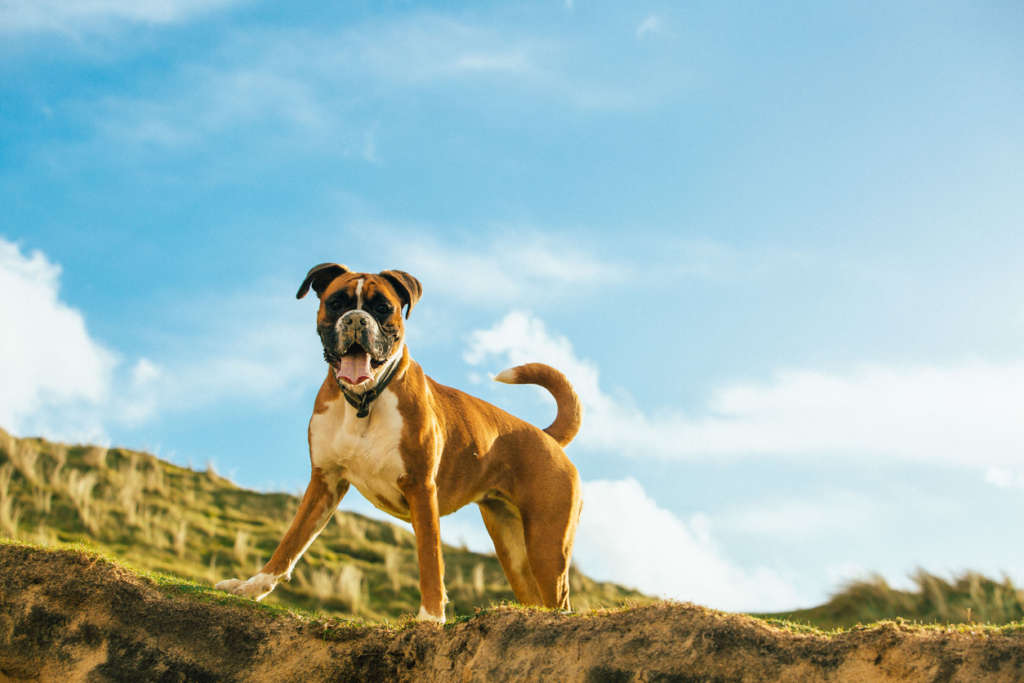

Boxer Grooming
When it comes to grooming fees, more dog mass means dishing out more dough. Boxers are on the bigger side, so you should budget $60–90 per visit. That said, thanks to their sleek, short coats, these stunning pups won’t exactly be regulars at the beauty salon—weekly brushing, baths every few months, and regular upkeep with $10 nail clippers will keep them looking fresh and clean.
Toys, Treats, Beds, & Accessories
Looking to treat your beautiful boxer like a king or queen? Then toys and treats are indispensable purchases. A year’s supply of treats can cost $60–110, while a one-time purchase of chew toys will run you about $100.
Let’s face it: your boxer deserves the best toys and treats. For the best of the best shipped right to you, try a monthly BarkBox. For $23/month, you’ll receive 2 bags of treats, 2 toys, and a meaty chew. The $29/month Super Chewer option gives you 2 durable dog toys, 2 treat bags, and 2 delicious chews—perfect for your boisterous boxer. Plus, DOUBLE YOUR FIRST BOX FOR FREE!
Aside from snacks and squeaky toys, your boxer budget should also include:
- A large dog bed ($45–120)
- A collar and leash ($15–30)
- An at-home crate ($70–$200)
- Dog walker ($20–$40 per walk)
- Pet insurance ($25–$60 per month)
Sources
Today. These 20 dog breeds are the most popular in America. Why? https://www.today.com/pets/pets/most-popular-dog-breeds-rcna22318
American Boxer Club. Short History of the Boxer Breed. https://www.americanboxerclub.org/boxer_history.html
Westminster Kennel Club. Best in Show Winners. https://www.westminsterkennelclub.org/best-in-show-winners
The People’s Dispensary for Sick Animals. Boxer. https://www.pdsa.org.uk/pet-help-and-advice/looking-after-your-pet/puppies-dogs/large-dogs/boxer


